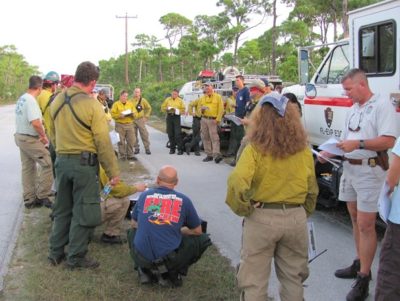National Key Deer Refuge Upcoming Prepwork for Start of 2017 Prescribed Burn Season

National Key Deer Refuge helps community reduce wildfire risk through vegetation thinning and prescribed burns
As the summer lightning-induced wildfire season returns, National Key Deer Refuge will be working to reduce fire fuels on Refuge natural areas on Big Pine Key, No Name Key and Cudjoe Key. These actions will help protect public and private lands from wildfires. Select vegetation will be removed mechanically by mowing and trimming using a skidsteer and hand trimming, with most vegetation thinning work being completed from June – November. Fire breaks will also be maintained in this manner to ensure that any wildfires can be well contained to reduce risk to private property. Reducing highly-flammable vegetation within the forest allows firefighters to control the spread of fire,minimizing risk to homes and businesses. These actions support and continue overall refuge efforts to reduce fire risk to public property and adjacent private property.

National Key Deer Refuge also plans to conduct carefully planned prescribed burns in several locations this year on Big Pine Key. Like mechanical vegetation thinning, prescribed fire is used to reduce the existing natural area fire hazard to both public and adjacent private lands while also improving wildlife habitat. Favorable weather conditions (i.e. recent rainfall, humidity, wind speed and direction) must be in accordance with fire plans before any burn can take place. Professional trained fire personnel from other national wildlife refuges, other federal agencies, as well as our state, county, and volunteer department partners come bringing specialized fire equipment to assist with prescribed fire on the Refuge. US Fish and Wildlife Service also uses prescribed fire as an important ecological tool to maintain the fire-dependent pine rocklands to benefit the native plants and animals such as the Key deer, Big Pine partridge pea, pineland croton, and Bartram’s scrub-hairstreak butterfly. Restoration and maintenance of the pine rockland habitat is essential for a healthy, fire-dependent ecosystem.
Community updates, up to and including when prescribed fire dates are proposed and when a prescribed fire occurs, will be announced through local print and radio press releases, the National Key Deer Refuge Facebook page and roadside advisory signs. Visitors and residents can find maps of proposed burn areas, in the Refuge Visitor Center located at 179 Key Deer Blvd, Big Pine Key (in the Big Pine shopping plaza across from Winn Dixie; Mon-Fri 9am -4pm, Sat 10 am-3 pm) and at our website http://www.fws.gov/nationalkeydeer/.
Private landowners are also encouraged to prepare their properties for the lightning fire season. Here’s a tip to help you protect your home or business from a wildfire:
The Florida Division of Forestry recommends maintaining a lean, clean and green landscape within 30 feet of any structure.
Lean = Small amounts of flammable vegetation. Keep grasses near structures cut short. Replace highly-flammable landscape material with fire resistant plants like Jamaican dogwood, gumbo limbo, sea grape, sweet acacia, green and silver buttonwoods, satin leaf and pigeon plum. Prune tree limbs to a height of 6-10ft.
Clean = No accumulations of dead vegetation. Cleaning dead leaves from where they accumulate in gutters, on roofs, under porches, in corners and under vegetation.
Green = Plants are healthy and green, and lawn is well irrigated to prevent wildfires.

